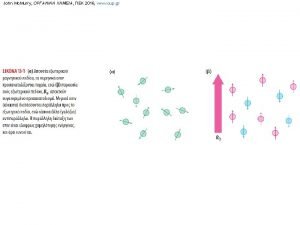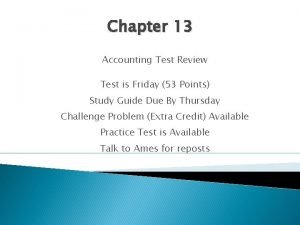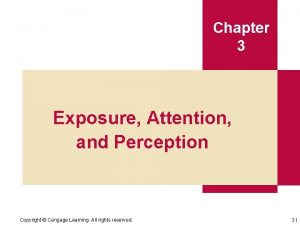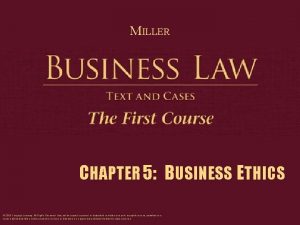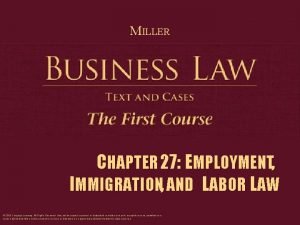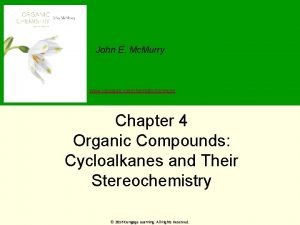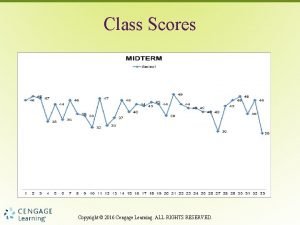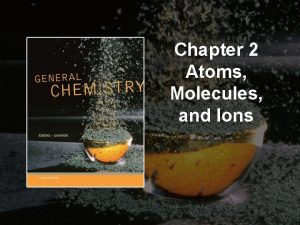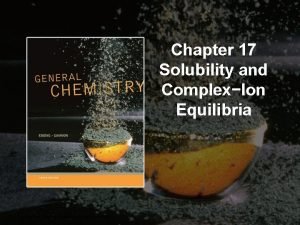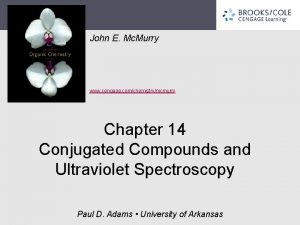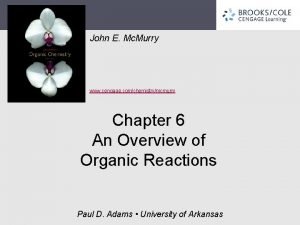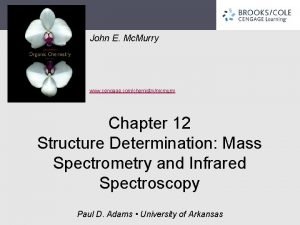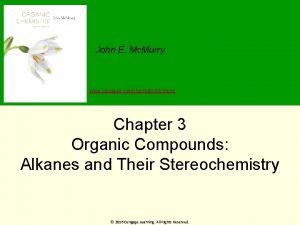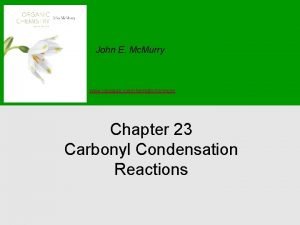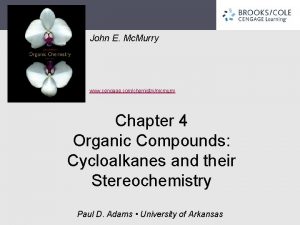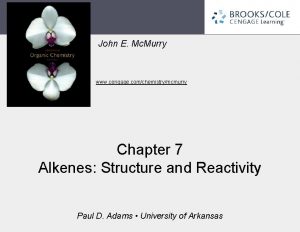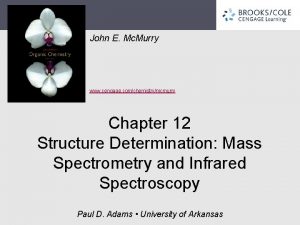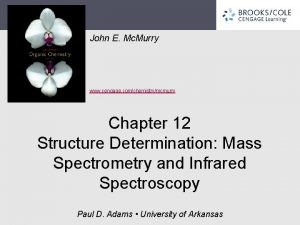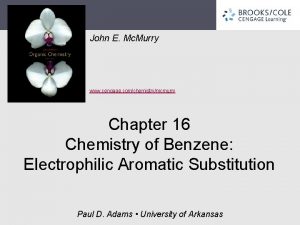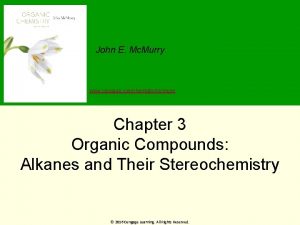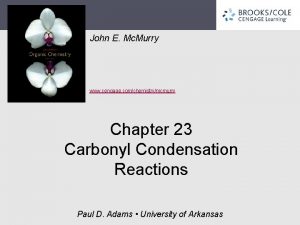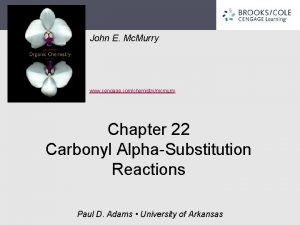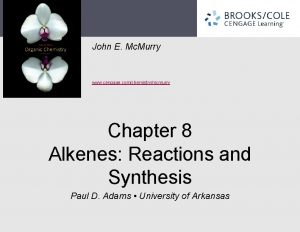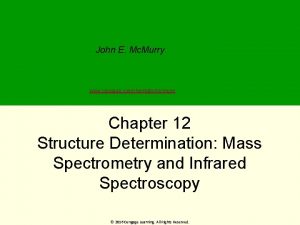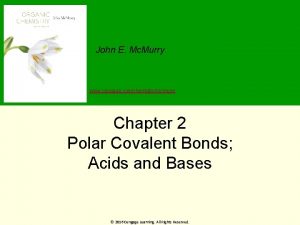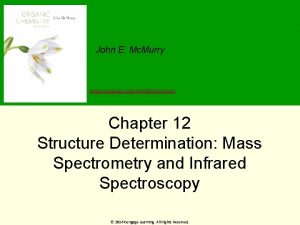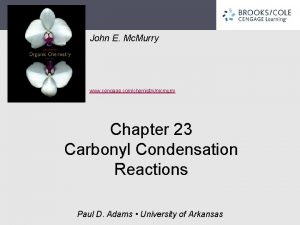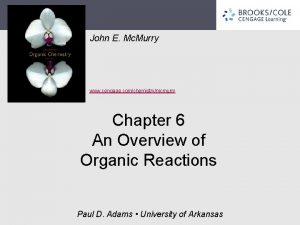John E Mc Murry www cengage comchemistrymcmurry Chapter






































































- Slides: 70

John E. Mc. Murry www. cengage. com/chemistry/mcmurry Chapter 7 Alkenes: Structure and Reactivity © 2016 Cengage Learning. All Rights Reserved.

Learning Objectives (7. 1) Industrial preparation and use of alkenes (7. 2) Calculating degree of unsaturation (7. 3) Naming alkenes (7. 4) Cis-Trans Isomerism in Alkenes (7. 5) Alkene Stereochemistry and the E, Z Designation © 2016 Cengage Learning. All Rights Reserved.

Learning Objectives (7. 6) Stability of alkenes (7. 7) Electrophilic addition reactions of alkenes (7. 8) Orientation of electrophilic additions: Markovnikov’s rule (7. 9) Carbocation structure and stability © 2016 Cengage Learning. All Rights Reserved.

Learning Objectives (7. 10) The Hammond Postulate (7. 11) Evidence for the mechanism of electrophilic additions: Carbocation rearrangements © 2016 Cengage Learning. All Rights Reserved.

Alkene-Hydrocarbon With Carbon–Carbon Double Bond Alkene: Hydrocarbon containing a carbon- carbon double bond Sometimes called olefin © 2016 Cengage Learning. All Rights Reserved.

Industrial Preparation and Use of Alkenes Ethylene and propylene are the least complex alkenes Important organic chemicals produced industrially © 2016 Cengage Learning. All Rights Reserved.

Thermal Cracking Ethylene, propylene, and butane are synthesized by steam cracking of light alkanes © 2016 Cengage Learning. All Rights Reserved.

Calculating Degree of Unsaturation Alkenes have fewer hydrogens than alkanes with the same number of carbons Referred to as unsaturated Degree of unsaturation: Number of multiple bonds or rings present in the molecule Formula for a saturated acyclic compound is Cn. H 2 n+2 Each ring or multiple bond replaces 2 H's © 2016 Cengage Learning. All Rights Reserved.

Calculating Degree of Unsaturation C 6 H 14 saturated C 6 alkane Degree of saturation is two © 2016 Cengage Learning. All Rights Reserved.

Calculating Degree of Unsaturation Organohalogens (C, H, X, where X = F, Cl, Br, I) Halogen replaces hydrogen C 4 H 6 Br 2 equals hydrocarbon formula C 4 H 8 have one degree of unsaturation © 2016 Cengage Learning. All Rights Reserved.

Calculating Degree of Unsaturation Organoxygen compounds (C, H, O) Oxygen forms 2 bonds Does not affect the formula of equivalent hydrocarbons May be ignored in calculating degrees of unsaturation © 2016 Cengage Learning. All Rights Reserved.

Calculating Degree of Unsaturation Organonitrogen compounds (C, H, N) Nitrogen forms three bonds Has one more H than a related hydrocarbon Subtracting number of N from number of H yields equivalent hydrocarbon formula © 2016 Cengage Learning. All Rights Reserved.

Worked Example Calculate the degree of unsaturation in each of the following formulas Draw the maximum number of structures for each a) C 4 H 8 b) C 4 H 6 c) C 3 H 4 Solution: a) C 4 H 8 Degree of saturation = 1 Structures: © 2016 Cengage Learning. All Rights Reserved.

Worked Example b) C 4 H 6 Degree of saturation = 2 Structures: c) C 3 H 4 Degree of saturation = 2 Structures: © 2016 Cengage Learning. All Rights Reserved.

Naming Alkenes Name the parent hydrocarbon Number the carbons in the chain so that double bond carbons have lowest possible numbers © 2016 Cengage Learning. All Rights Reserved.

Naming Alkenes Write the full name Number substituents: According to position in chain Alphabetically Rings have cyclo as prefix © 2016 Cengage Learning. All Rights Reserved.

Table 7. 1 - Common Names of Some Alkenes © 2016 Cengage Learning. All Rights Reserved.

Worked Example Give IUPAC names for the following compounds a) b) © 2016 Cengage Learning. All Rights Reserved.

Worked Example Solution: a) The longest chain is a pentene Consists of three methyl groups The methyl groups are attached to C 3 and C 4 Using tri- before methyl and using numbers to signify the location of the double bond The compound is 3, 4, 4 -Trimethyl-1 -pentene © 2016 Cengage Learning. All Rights Reserved.

Worked Example b) The longest chain is a hexane The methyl group is attached to C 3 Using numbers to signify the location of the double bond The compound is 3 -Methyl-3 -hexene © 2016 Cengage Learning. All Rights Reserved.

Worked Example Name the following cycloalkenes: a) b) © 2016 Cengage Learning. All Rights Reserved.

Worked Example Solution: a) 1, 2 -Dimethylcyclohexene b) 4, 4 -Dimethylcycloheptene © 2016 Cengage Learning. All Rights Reserved.

Cis-Trans Isomerism in Alkenes Carbon atoms in a double bond are sp 2 - hybridized Three equivalent orbitals at 120°separation in the plane Interaction of p orbitals, one bonding and one antibonding molecular orbital Rotation prevented by bond Barrier to double-bond rotation must be as great as the strength of p bond About 350 k. J/mol © 2016 Cengage Learning. All Rights Reserved.

Cis-Trans Isomerism in Alkenes Rotation of bond is prohibitive This prevents rotation about a carbon–carbon double bond © 2016 Cengage Learning. All Rights Reserved.

Cis-Trans Isomerism in Alkenes Methyl groups in 2 -butene are either on the same side of the double bond or on opposite sides Compound with substituents on the same side of double bond is called cis-2 -butene Isomer with substituents on opposite sides is trans-2 -butene Cis-trans isomerism occur whenever both double -bond carbons are attached to two different groups © 2016 Cengage Learning. All Rights Reserved.

Figure 7. 3 - Cis and Trans Isomers of 2 -Butene © 2016 Cengage Learning. All Rights Reserved.

Cis-Trans Isomerism in Alkenes Cis-trans isomerization requires end groups to differ in pairs Not possible if one of the double-bond carbons is attached to two identical groups © 2016 Cengage Learning. All Rights Reserved.

Worked Example Draw the structure of cis-9 -tricosene Solution: Cis-9 -tricosene © 2016 Cengage Learning. All Rights Reserved.

Alkene Stereochemistry and the E, Z Designation Tri- and tetra-substituted double bonds require more general method E, Z system: Method used for describing alkene stereochemistry Uses Cahn–Ingold–Prelog sequence rules © 2016 Cengage Learning. All Rights Reserved.

Alkene Stereochemistry and the E, Z Designation Rule 1 Rank the substituent atoms according to the atomic number of the first atom Higher atomic number gets higher priority © 2016 Cengage Learning. All Rights Reserved.

Alkene Stereochemistry and the E, Z Designation Rule 2 If atomic numbers are the same, compare at next connection point at same distance © 2016 Cengage Learning. All Rights Reserved.

Alkene Stereochemistry and the E, Z Designation Rule 3 Multiple-bonded atoms are equivalent to the same number of single-bonded atoms © 2016 Cengage Learning. All Rights Reserved.

Alkene Stereochemistry and the E, Z Designation Z geometry: Molecules which have higher ranked groups on each carbon are on the same side of the double bond E geometry: Molecules which have higherranked groups are on opposite sides © 2016 Cengage Learning. All Rights Reserved.

Worked Example Assign stereochemistry (E or Z) to the double bond in the following compound Convert the drawing into a skeletal structure (red = O) © 2016 Cengage Learning. All Rights Reserved.

Worked Example Solution: © 2016 Cengage Learning. All Rights Reserved.

Stability of Alkenes Cis alkenes are less stable than trans alkenes Less stable isomer is higher in energy and gives off more heat Tetrasubstituted > trisubstituted > disubstituted > monosusbtituted © 2016 Cengage Learning. All Rights Reserved.

Figure 7. 5 - Energy Diagrams for Hydrogenation of cis- and trans-2 -Butene © 2016 Cengage Learning. All Rights Reserved.

Table 7. 2 - Heats of Hydrogenation of Some Alkenes © 2016 Cengage Learning. All Rights Reserved.

Hyperconjugation Electrons in neighboring filled orbital stabilize vacant antibonding orbital Net positive interaction Stability of the alkene depends on the number of hyperconjugation that occurs © 2016 Cengage Learning. All Rights Reserved.

Worked Example Which compound in each pair is more stable a) b) © 2016 Cengage Learning. All Rights Reserved.

Worked Example Solution: a) b) © 2016 Cengage Learning. All Rights Reserved.

Electrophilic Addition of Alkenes General reaction mechanism of electrophilic addition Attack on electrophile, such as HBr, by bond of alkene Produces carbocation and bromide ion Carbocation is an electrophile, reacting with a nucleophilic bromide ion © 2016 Cengage Learning. All Rights Reserved.

Figure 7. 7 - Mechanism © 2016 Cengage Learning. All Rights Reserved.

Figure 7. 8 - Energy Diagram for the Two-step Electrophilic Addition of HBr to 2 -Methylpropene © 2016 Cengage Learning. All Rights Reserved.

Electrophilic Addition of Alkenes Reaction is also successful with HCl, HI, and H 2 O HI is generated from KI and phosphoric acid © 2016 Cengage Learning. All Rights Reserved.

Orientation of Electrophilic Additions: Markovnikov’s Rule In electrophilic addition reactions, unsymmetrical substituted alkenes give a single product Regiospecific: Reaction in which only one of two possible orientations of an addition occur © 2016 Cengage Learning. All Rights Reserved.

Markovnikov’s Rule In the addition of HX to an alkene H attaches to the carbon with fewer alkyl substituents X attaches to the carbon with more alkyl substituents © 2016 Cengage Learning. All Rights Reserved.

Markovnikov’s Rule (restated) In the addition of HX to an alkene, more highly substituted carbocation forms as the intermediate rather than the less highly substituted one © 2016 Cengage Learning. All Rights Reserved.

Markovnikov’s Rule (restated) © 2016 Cengage Learning. All Rights Reserved.

Worked Example Predict the products of the following reaction: Solution: The reaction is electrophilic addition of HX to an alkene Using Markovnikov's rule to predict orientation © 2016 Cengage Learning. All Rights Reserved.

Worked Example What alkene is required to prepare the following product: © 2016 Cengage Learning. All Rights Reserved.

Worked Example Solution: Choose the alkene starting material for synthesis of the desired haloalkane © 2016 Cengage Learning. All Rights Reserved.

Carbocation Structure and Stability Carbocations are planar The trivalent carbon is sp 2 -hybridized The six valence electrons on carbon are used in the three s bonds The p orbital is unoccupied Stability increases with increasing substitution © 2016 Cengage Learning. All Rights Reserved.

Carbocation Structure and Stability Plot of dissociation enthalpy shows Highly substituted alkyl halides dissociate more easily than less substituted ones © 2016 Cengage Learning. All Rights Reserved.

Carbocation Structure and Stability Highly substituted carbocations are more stable than less substituted ones due to: Inductive effects © 2016 Cengage Learning. All Rights Reserved.

Carbocation Structure and Stability Hyperconjugation Higher the number of alkyl groups, more possibilities for hyperconjugation and more stable the carbocation © 2016 Cengage Learning. All Rights Reserved.

Worked Example Show the structures of the carbocation intermediates expected in the reaction Solution: © 2016 Cengage Learning. All Rights Reserved.

The Hammond Postulate It is possible to get a picture of what a given transition state looks like by analysing the structure of the nearest stable species Exergonic reactions have transition states that resemble a reactant Endergonic reactions have transition states that resemble a product Transition state is the highest energy species in a reaction step © 2016 Cengage Learning. All Rights Reserved.

Figure 7. 13 - Energy Diagrams for Two Similar Competing Reactions © 2016 Cengage Learning. All Rights Reserved.

The Hammond Postulate Transition state for an endergonic reaction step structurally resembles the product of that step Conversely, transition state for an exergonic reaction step structurally resembles the reactant for that step © 2016 Cengage Learning. All Rights Reserved.

The Hammond Postulate Faster reaction gives more stable intermediate Stability is reflected in the lower-energy transition state More the alkyl groups that are present: Greater the extent of stabilization Faster the transition state forms © 2016 Cengage Learning. All Rights Reserved.

Worked Example What about the second step of electrophilic addition of HCl to an alkene – the reaction of chloride ion with the carbocation intermediate? Is this step exergonic or endergonic? Does the transition state for this second step resemble the reactant or product? Draw what the transition-state structure might look like Solution: The second step in the electrophilic addition of HCl to an alkene is exergonic According to the Hammond postulate, the transition state should resemble the carbocation intermediate © 2016 Cengage Learning. All Rights Reserved.

Worked Example Transition-state structure © 2016 Cengage Learning. All Rights Reserved.

Evidence for the Mechanism of Electrophilic Addition: Carbocation Rearrangements Carbocations undergo structural rearrangements during reaction of HX with an alkene Hydride shift: Shift of a hydrogen atom and its electron pair between neighboring carbons © 2016 Cengage Learning. All Rights Reserved.

Evidence for the Mechanism of Electrophilic Addition: Carbocation Rearrangements Carbocation rearrangements can occur by the shift of an alkyl group with its electron pair Secondary carbocation rearranges to a more stable tertiary carbocation by the shift of a methyl group © 2016 Cengage Learning. All Rights Reserved.

Hydride Shift in Biological Molecules © 2016 Cengage Learning. All Rights Reserved.

Worked Example On treatment with HBr, vinylcyclohexane undergoes addition and rearrangement to yield 1 -bromo-1 -ethylcyclohexane Using curved arrows, propose a mechanism to account for this result © 2016 Cengage Learning. All Rights Reserved.

Worked Example Solution: Step 1 - Electrophilic addition of H+ to double bond Step 2 - Hydride shift that forms a more stable tertiary carbocation Step 3 - Reaction of carbocation with Br© 2016 Cengage Learning. All Rights Reserved.

Summary Alkene is a hydrocarbon that contains a carbon double bond Alkenes are said to be unsaturated because they contain fewer hydrogens than alkanes with the same number of carbons If the higher-ranking groups on each carbon are on the same side of the double bond, the geometry is Z If the higher-ranking groups on each carbon are on opposite sides of the double bond, the geometry is E Alkene chemistry is dominated by electrophilic addition reactions © 2016 Cengage Learning. All Rights Reserved.

Summary Markovnikov’s rule predicts that the H group will add to the carbon having fewer alkyl substituents and the X group will add to the carbon having more alkyl substituent Hammond postulate states that the transition state of an exergonic reaction step structurally resembles the reactant, whereas the transition state of an endergonic reaction step structurally resembles the product Rearrangements occur by shift of either a hydride ion, : H- (a hydride shift), or an alkyl anion, : R-, from a carbon atom to the neighboring positively charged carbon © 2016 Cengage Learning. All Rights Reserved.
 Mc murry
Mc murry Chapter 7:10 respitory system
Chapter 7:10 respitory system Cengage chapter 7
Cengage chapter 7 Chapter 13 medical math assignment sheet
Chapter 13 medical math assignment sheet Chapter 13 accounting
Chapter 13 accounting Copyright cengage learning. powered by cognero
Copyright cengage learning. powered by cognero Medical terminology chapter 5 learning exercises answers
Medical terminology chapter 5 learning exercises answers Chapter 8 the digestive system labeling exercises
Chapter 8 the digestive system labeling exercises Cengage chapter 5 medical terminology
Cengage chapter 5 medical terminology Matching muscle directions and positions
Matching muscle directions and positions Prescription terms
Prescription terms Cengage differential equations
Cengage differential equations Century 21 bank
Century 21 bank Cengage differential equations
Cengage differential equations Delmar cengage learning medical terminology
Delmar cengage learning medical terminology Cengage learning heart diagram
Cengage learning heart diagram Cengage
Cengage Cengage
Cengage Cengage
Cengage South-western cengage learning
South-western cengage learning Cengage
Cengage Cengage
Cengage Artist
Artist 2009 delmar cengage learning
2009 delmar cengage learning Cengage learning heart diagram
Cengage learning heart diagram Introduction to medical terminology chapter 1
Introduction to medical terminology chapter 1 Cengage learning australia
Cengage learning australia Graphing tpr
Graphing tpr Whille
Whille Cengage learning
Cengage learning Module 1 computer concepts exam cengage
Module 1 computer concepts exam cengage Cengage
Cengage Wadsworth cengage learning
Wadsworth cengage learning Cengage
Cengage Cengage learning
Cengage learning Cengage
Cengage Cengage learning plant cell
Cengage learning plant cell Cengage
Cengage Cengage learning
Cengage learning Motivation, ability, and opportunity consumer behaviour
Motivation, ability, and opportunity consumer behaviour Cengage learning
Cengage learning Consumer diversity in consumer behaviour
Consumer diversity in consumer behaviour Dissociative
Dissociative Brooks cole cengage learning
Brooks cole cengage learning Cengage interview process
Cengage interview process Cengage
Cengage Cengage
Cengage Word module 2 creating a research paper
Word module 2 creating a research paper Sequence and series cengage
Sequence and series cengage Outcome based ethics
Outcome based ethics 2014 cengage learning accounting answers
2014 cengage learning accounting answers Cengage
Cengage Quadratic equation cengage
Quadratic equation cengage Cengage layoffs
Cengage layoffs Matrices formulas
Matrices formulas Cengage.com
Cengage.com Cengage learning
Cengage learning Cu webassign
Cu webassign Cengage learning
Cengage learning 2009 delmar cengage learning
2009 delmar cengage learning Cengage.com
Cengage.com Color blindness medical term cengage
Color blindness medical term cengage Green vitriol formula
Green vitriol formula Cengage
Cengage Cengage learning
Cengage learning 2009 delmar cengage learning
2009 delmar cengage learning Cengage learning
Cengage learning 2012 cengage learning
2012 cengage learning The layoff cengage
The layoff cengage Solomon four group design
Solomon four group design Cengage learning psychology
Cengage learning psychology
